You just know it's going to be a great trip.
The Sighisoara Clock Tower
The Last of Transylvanias Saxons
Great BBC article on Romanian Germans
The origins of Sighisoara city go back to the Roman times. During the First Century AD, the Dacians (ancient inhabitants of the territory of modern Romania which eventually developed into the current Romanian people), built a fortification and called it Sandava.
Useful traveler's map of Sighisoara from 1735.
Under the Roman administration it was known as Castrum Stenarum. Then, during the 12th century, the Transylvanian Saxons built a new citadel which was named Schäßburg. Sighisoara (Schäßburg - Schassburg or Schäsbrich in German) still stands as one of the most beautiful and best-preserved medieval towns in all of Europe. It was designated as a World Heritage Site by UNESCO. This perfectly intact 16th century gem with nine towers, cobble-stoned streets (which were very difficult to walk on by the way), burgher houses and ornate churches. It is also the birthplace of Vlad Dracula, also known as Vlad Tepes (or Vlad the Impaler), Ruler of the province of Walachia from 1456 to 1462. It was he who inspired Bram Stoker's fictional creation, Count Dracula.
His house is just one of the many attractions to see here in Sighisoara. Others include the Church on the Hill with its 500-year-old frescoes, the 13th century Venetian House and the Church of the Dominican Monastery, well-known in Romania for its Transylvanian Renaissance carved altar piece, baroque pulpit, Oriental carpets, and 17th century brass organ.
Sighisoara's citadel was built in the 12th century, when it was known as Castrum Sex (Fort Six - sounds more adult-oriented in Latin 😜),. It was further strengthened and extended around the 15th century.
In 1298, the town was first mentioned as "Schespurch." Then, in 1367 it was called Civitas de Seguswar. The name of Sighisoara was first identified in a written document issued by Vlad Dracul, Vlad the Impaler's father, in 1431.
In the 14th and 15th centuries, with the influx of Saxons into the region, the economic growth recorded by Sighisoara's craftsmen and tradesmen ensured financial prosperity. This accumulation of wealth helped the local citizens in the construction of a strong defense system which provided 14 towers and several bastions with artillery directed to all four directions around the fortress. Each tower was built, maintained, and defended by a particular craft guild.
The Clock Tower
The Citadel from outside the city walls. Visitors to the city had to enter through this portal.
View from the observation deck of the Clock Tower
By far, the most striking of the towers is the 14th century Clock Tower. The thickness of the base walls are 7 feet 6 inches (2.35 meters) and 4 feet 4 inches (1.30 meters) on the second floor. This tower acted as the main gate of the half-mile-long defensive wall, was used to store the city's most valued treasures, and served as the town hall until 1556. Since 1899, it has housed the History Museum. From the top of the Clock Tower, you can look down over the red-tiled roofs of Old Town and see perfectly intact 16th century Saxon houses lining the narrow cobblestone streets. Today, local merchants and craftsmen still tend to their business, just as they did centuries ago.
Although Sighisoara was not the biggest or richest of the seven Saxon walled citadels in Transylvanian (my goal while here is to visit all seven), it has become one of the most popular among tourists. A walk through the town's quite hilly streets (with their original medieval architecture), the whimsical mix of winding cobbled alleys, steep stairways, secluded squares, towers, turrets, and incredibly well-preserved citadel, is like stepping back in time to the 12th century. I don't know where else you can experience this outside Romania.
As soon as you enter the main square of the Citadel is a house with a stag head protruding from it. It's hard to miss when you look up and see this interesting curiosity.
So I learn, the house was rebuilt in the Transylvanian renaissance style in 1691 after being destroyed in the 1676 fire which destroyed a major part of Sighisoara. The house takes its name from the stag skull (trophy) on the northwest corner of its facade.
In 1691 the house was owned by Michael Deli, the mayor of Sighisoara, and then in the 18th century by the noble families, von Sternburg Kelp and Csech von Sternheim.
Restorations in the early 2000’s revealed an external mural depicting the stag’s body.
Today the building is a hotel, with a ground floor that doubles as a cellar bar/restaurant. I did not stay in the hotel nor did I eat in the restaurant so can’t comment on either as my hotel (Hotel Sighisoara) was right across the street.
These are exhausting steps, six inches tall but nearly 18" deep.
Sighisoara's Clock Tower, which to some is also known as the Council Tower, was built in the second half of the 14th century and expanded in the 16th century. The four small corner turrets on top of the tower symbolized the judicial autonomy of the Town Council. Unlike many smaller councils in the region, this autonomy could apply, if necessary, the death penalty. At 210 feet (64 meters) tall, the tower is visible from almost every corner of the city.
After a fire in 1676, when the town's gunpowder deposits which had been stored in the Tailors' Tower exploded, rebuilt the roof of the tower in its existing Baroque style. The multicolored, geometrical tile patterns on the tower roof are relatively recent, dating from a renovation in 1894 in which Austrian artists, the Leonhardt brothers, carried out. Its amazing how the sun reflects off these brightly colored tiles.
In the 17th century, a two-plate clock, with figurines carved from local Linden wood, was installed at the top of the tower, with one dial looking over the Lower Town, and the other facing the Citadel. The figurines, which are moved by the clock's internal mechanism, each represent a different character. On the citadel side is a figure of Peace holding an olive branch. Accompanying this is a drummer who beats the hours on his bronze drum. Above them is Justice, with her set of scales, and Law, wielding a sword. These are accompanied by two angels representing Day and Night. At 6 am every morning, the angel symbolizing the day appears and marks the beginning of the work day. At 6 pm, the angel symbolizing the night comes out carrying two burning candles, marking the end of the work day. To watch this is incredible considering it is over 400 years old - nearly twice the age of anything in America. This intricate two-plate clock has been working continuously since the Middle Ages.
The dial overlooking the Lower City features a set of seven figures, each representing the pagan gods who personified the days of the week: Diane (Monday), Mars (Tuesday), Mercury (Wednesday), Jupiter (Thursday), Venus (Friday), Saturn (Saturday), and the Sun (Sunday).
The tallest spire of the tower ends in a small golden globe. Then, at the top, there's a meteorological weathervane cock, which turns around by air currents and forecasts the weather. The gilded ball is said to house a text by Georgius Krauss named “The Chronicle of the Clock Tower” along with other documents describing the city’s history and that of the region’s ethic Germans who dominated the city in its early times.
The Torture Room - This small but interesting museum is housed at the foot of the Clock Tower in the same room where prisoners were tortured and confessions were extorted during the Middle Ages. Some amazing torture instruments and methods are on display and well worth the small entrance fee.
Vlad Dracul
Obelisk honoring Vlad Dracul
Vlad Dracul's House (Casa Dracula)
Vlad Dracul's House is located in the Citadel Square, close to the Clock Tower. This tan-colored house is the place where Vlad Tepes, the inspiration for Bram Stoker's famous Dracula, was born in 1431 and lived with his father, Vlad Dracul, until 1435 when they moved to Targoviste. A wrought-iron dragon hangs above the entrance (you'll see why soon). The ground floor of the house now serves as a restaurant, while the first floor is home to the Museum of Weapons (which seemed to have nothing to do with Vlad Tepes but it is where young Vlad’s bedroom was, which he slept in until the age of four). It was really cool to visit as you can imagine but is overly commercialized with vampires and other monsters of all sorts.
The Romanians may say they've heard enough Dracula jokes and references but it seems to be a pretty good tourist attraction. It’s unclear if Sighisoara fully embraces its affiliation with Dracula or loathes it. About a decade ago, a plan was devised to construct a Dracula-themed amusement park near Sighisoara. Petitions from residents and other Romanians ultimately nipped it in the bud.
The Romanians may say they've heard enough Dracula jokes and references but it seems to be a pretty good tourist attraction. It’s unclear if Sighisoara fully embraces its affiliation with Dracula or loathes it. About a decade ago, a plan was devised to construct a Dracula-themed amusement park near Sighisoara. Petitions from residents and other Romanians ultimately nipped it in the bud.
For his great deeds in protecting the region, the citizens bestowed upon him the Order of the Dragon, hence the title Dracul. The Latin word for dragon is draco and this symbology appears throughout Romanian history even as early as the ancient Dacians. While in medieval lure dragons served as symbols of independence, leadership, strength, and wisdom. The Biblical association of the devil with the serpent that tempted Adam and Eve, gave the snake-like dragon connotations of evil. Thus, the Romanian word Dracul stands for both dragon and devil in English terms.
Benefiting from the friendship of the Hungarian king, Sigismund I of Luxembourg, Vlad II Dracul, the father of Vlad Tepes, spent his youth at the royal court and later distinguished himself as a brave knight in the fight against the Ottoman Empire.
Dracula, the title of Vlad Tepes, translates as "Son of Dracul".
The other Fortification Towers include:
The Tinsmiths' Tower
The Tinsmiths' Tower
The Cobblers' (Shoemaker's) Tower
The Tanner's Tower
The Tailors' Tower
The Blacksmith's Tower
The Furriers' Tower
The Ropemakers' Tower
The Butchers' Tower
The Tanner's Tower
The Tailors' Tower
The Blacksmith's Tower
The Furriers' Tower
The Ropemakers' Tower
The Butchers' Tower
During the 12th century, in an effort to protect the eastern borders of the Hungarian kingdom, the King of Hungary invited German craftsman and merchants to Transylvania and what's now known as the village of Sighisoara. The city wasn't only in a very strategic location, but it had also become a center for merchants and artisans. It had become one of the most important cities in the Transylvanian region. As I stated earlier, each craftsman guild was responsible for building, maintaining, and defending one of the 14 fortification towers in the city. The towers were unique, in that they were fortresses in and of themselves. Meaning, even if one was captured, the integrity of the city as a whole would continue unimpinged.
Today, along the half-mile defensive walls, only 9 of the 14 fortification towers remain. You can observe all of the towers from the outside, however only one, the Clock Tower, is open to the public. As a side-note into the town's lengthy history, a large fire engulfed Sighisoara in 1676 and many of the towers, homes, and buildings were destroyed or damaged and later underwent repairs and rebuilding.
The Tinsmiths' Tower was built in the 13th century and is 82 feet (25 meters) high. This tower is uniquely shaped and has a square base, followed by a pentagonal section added in the 16th century, and then topped with a widened eight-sided section, and a hexagonal tiled roof. If you look closely, you can still see the damage to the tower from bullets during a siege by Hungarians (1704-1706). Incredible to observe.
Tinsmith Tower
The Cobblers' (or Shoemaker) Tower protects the northeast side of the Citadel. The original tower was destroyed in the 1676 fire and the current one was built in 1681. Also, the bastion of artillery for this tower was destroyed in 1846 and the wooden staircase on the tower wasn't added until 2001.
The Cobbler's or Shoemaker's Tower
The Tanners' Tower dates back to the 13th and 14th centuries and is in the southeast part of the citadel. Its purpose was to protect the town square and the courtyard of the Clock Tower. Amazingly, this tower was one of the few buildings not damaged by the 1676 fire.
The Tanner's Tower - I think one of the cooler structures.
Looking back upon the Tailor's Tower. We parked down the street and to the left at the bottom of the hill on the outside of the city. Later the next day, we saw a beautiful wedding procession coming through these arches.
The Blacksmiths' Towers primary purpose was to protect the Monastery Church. As such, it's located behind the church and on the northeast side of the Citadel. The tower was re-purposed as a fire station in 1874. When viewing it from the inside of the Citadel walls, you can be easily fooled by it's short stature but when you see it from outside the walls, it's impressively large.
You can see from this angle how tall the Blacksmith Tower is. Hanging off the wall at an awkward angle to get this picture raised some eyebrows about silly Americans.
The Furriers' Tower has the simplest design of all the towers and dates to the 14th century. It was rebuilt in the 16th century and repairs were necessary after it received damage from the 1676 fire. The Furriers' Tower stands adjacent to a gate into the Sighisoara Citadel. The morale of the story is, it benefited greatly to be a tailor rather than a furrier in the 14th and 15th centuries.
The Furrier's were pretty popular I'm sure. With an abundance of wolves and bear and then the cold mountainous Transylvanian winters, these craftsmen's wares were always in high demand.
The Ropemakers' Tower dates back to the 13th century and is thought to be one of the oldest buildings in Sighisoara because its foundations are on the pre-Saxon citadel walls. It's also the only remaining inhabited tower of the nine in Sighisoara. It's currently used as a guard house for the cemetery of the 'Church on the Hill' in Sighisoara. I visited the cemetery and learned why there were so many names on the gravestones. It seems, because the city has been inhabited for over 700 years, there is limited space for grave sites. Therefore, to fit more people into the graveyard, they bury more people by stacking them one on top of the other (sometimes 5-6 deep).
The Ropemaker's Tower. This is more like a really tall house than a fortified tower but it is one of the coolest and can you imagine someone still lives in here - the keeper of the cemetery.
The Butchers' Tower protects the western side of the Citadel and was originally built in the 15th century. It had to be re-built in the 16th century to raise it above the bastion built directly in front of it so that it would enlarge the field of view. During its rebuilding, it was reconstructed in a hexagonal shape with three floor and historical writings indicate it housed five arquebuses (long guns), a few cannonballs, and gunpowder. I guess being a butcher was pretty lucrative in those days also.
The Butcher's Tower
This plaque was on the wall adjacent to my hotel. The library wasn't open during my stay here but I would have loved the opportunity to peruse it's contents.
Giant marionette figures (kinda creepy)
Afinata is a traditional Romanian alcoholic drink made from blueberries. To best describe afinata, try to think about going to IHOP and ordering pancakes. On your table are a selection of syrups with one of them being blueberry. Now open the bottle and take a shot, only imagine the syrup being 60% alcohol! It was actually pretty good and after taste testing some local Bergenbier and some afinata - it was a great night out with the CO, the XO, and Stefania, our MWR Director.
We'll start with a course of chicken wings, Mici, mushrooms, French fries, and flat bread.
Then we'll share some steamed mussels.
Try to think of a Cinnabon wrapped around a rolling pin-like tool and baked over coals then drizzled with honey and sprinkled with ground nuts or powdered sugar. This is what these incredible Romanian traditional desserts taste like, only in this setting even better.
A Kurtoskalacs and capuccino break!
Who remembers Punch and Judy? This was one of the many booths at the festival which harkened back to days long gone. Will any of our children even know Punch and Judy?
View from the top of the Ropemaker's Tower, looking down on the citadel spire.
Now it's time to make the climb up to the upper district of the city where the church, the cemetery, and the school reside. It is a pretty good hike up these stairs to see the fortified ‘Church on the Hill’ & the German cemetery.
I thought this was a rack to stretch people (silly me) but instead it is the tool they used to lower the sarcophagus and their lids down into the graves.
After descending down from the church a little ways to see the cemetery, I witness sections of the fortress walls in a state of disrepair and in some parts fallen. Romania is seeking funding from the European Union to restore the walls in Sighisoara but until then, we can only hope we don't lose these incredible structural artifacts.
This passageway through one of the fortification walls shows the thickness - nearly seven feet!
This is the mint where Vlad Dracul printed the currency for his region.
Seems appropriate for "Dracula's birthplace" to have a cemetery like this!
Ok, so here's a random picture - how about a Mercedes-Benz pick-up truck?
Is this a pet baby bear or just the cutest puppy you've ever seen?














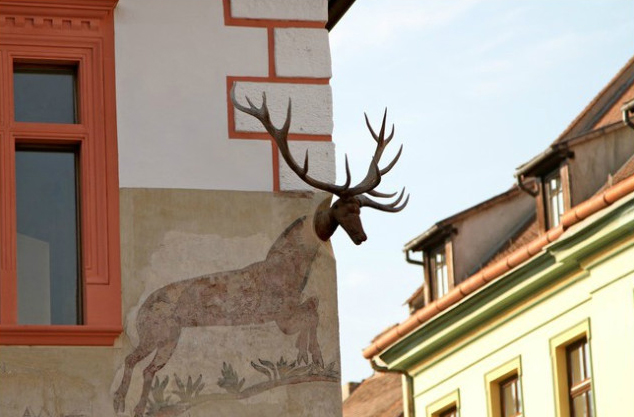




















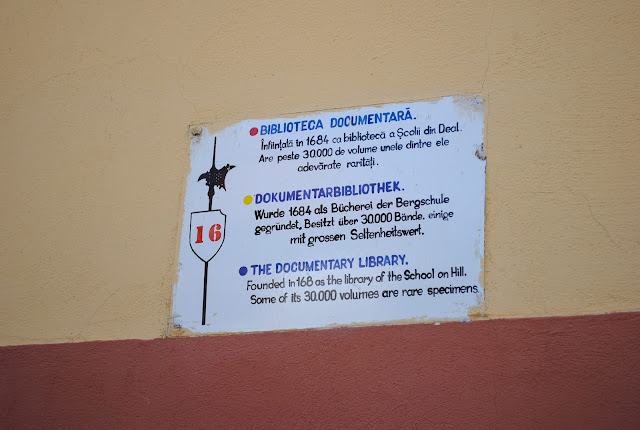





































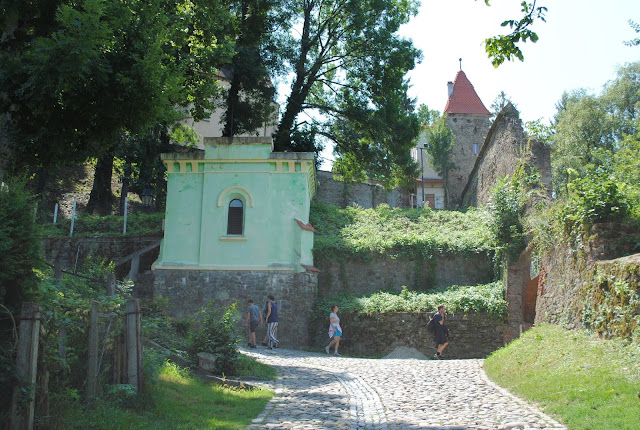
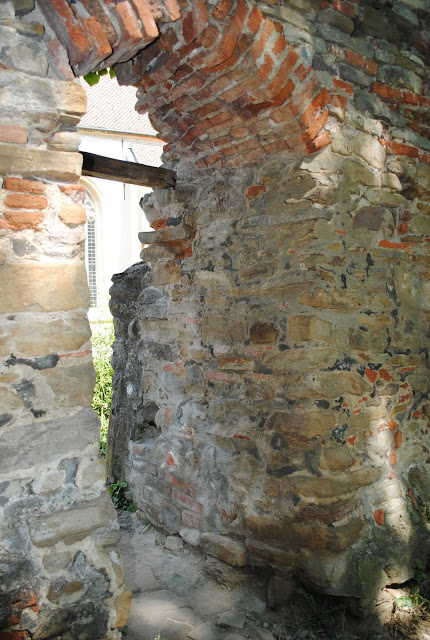








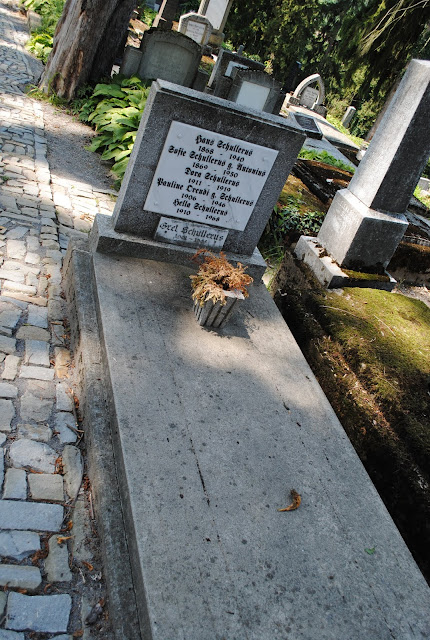





No comments:
Post a Comment